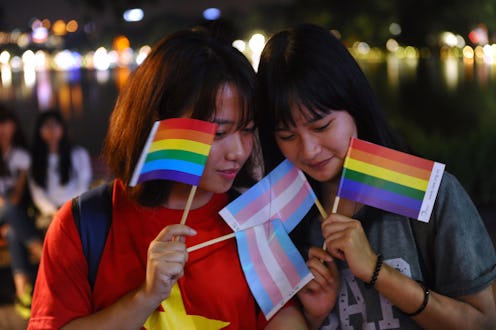Between achieving marriage equality and progressive employment protection, the LGBTQ community has had a good year, and it seems like things are only looking brighter in the near future. With an expected launch date of April 2017, Anteros Cruises is the first dedicated LGBT cruise line in existence. Yes, you read that correctly — a cruise line exclusively for LGBT people and their families. The cruise is expected to run year-round, allowing people ample flexibility in their schedules; furthermore, the year-round schedule means that the small ship, expected to carry around 400 people at a time, won't make guests feel overcrowded or congested on the vessel.
So, just where will this LGBT cruise take you? Itineraries aren't entirely final as of now, but according to Travel Pulse, we can expect trips operating in the Mediterranean and the Caribbean. In summer months, the ship's home ports will be in Barcelona and Piraeus (Athens) and in the winter, St. Marteen and Colon will be the ship's base in the Caribbean. In case you were wondering, itineraries are indeed being developed with LGBT events in mind, so yes, Pride events may overlap with the ship's schedule.
As details are still forthcoming, you can't plan your vacation just yet, but the company has offered some specifics to get our daydreams started. In terms of trip length, we can expect journeys to range between five and 14 days. Cost? Still to be announced, but Anteros assures us that there will be a "wide range... of fares to accommodate many budgets." Given that the ship is described as a luxury vessel, including fine dining, custom shore excursions, and celebrity-designer interior spaces, we should probably start saving now.
Of course, the very notion of an LGBT-specific cruise line raises an important question: Why do we need one at all? Can't LGBT people go on a cruise with straight people? While LGBT people certainly can (and do!) go on cruises with heterosexual and cisgender people all the time, these spaces are not always LGBT-inclusive, and don't always travel to locations which are safe for LGBT people to be out. In fact, the LGBT community still faces a lot of obstacles while traveling. Here are three of the most common issues:
1. Pushing Twin Beds Together Is Not Fun
For opposite-sex couples, checking into a hotel room comes with the assumption that you'll be granted a room with a single bed, large enough to hold two people. For same-sex couples, this arrangement can get really tricky, as hotel clerks will often attempt to provide you with a room with two separate beds. Is this just courtesy? I don't think so. (The courteous response in this scenario is to simply ask whether the guest would prefer a single or double bed).
Sophie Ward, for example, writes in The Guardian about her frustrating experience during a family vacation in the Caribbean, saying, "No one said another word to us about our sleeping arrangements, but we knew that even if the hotel was happy to take our booking, the community and local custom did not accept us as a family, and we felt foolish for having thought it might be otherwise." While travel and vacations can still be fun and enriching experiences, these negative interactions can feel very isolating and distressing.
2. Traveling While Transgender Is Terrifying
The transgender community routinely faces adverse hardships in daily life, and unfortunately, travel is no exception. Even boarding a flight can take on additional challenges for transgender individuals. In Septemeber of 2015, trans woman Shadi Petosky shed light on just how difficult it can be when she live-tweeted her experience being held at the Orlando International Airport because of an "anomaly" — that is, her penis.
A spokesperson for the TSA did respond to Mashable on the subject, saying in a statement:
Our officers are trained to properly screen members of the transgender community. TSA takes all potential civil rights violations very seriously and conducted a review of the incident. After examining closed circuit TV video and other available information, TSA has determined that the evidence shows our officers followed TSA’s strict guidelines. Supervisory personnel and a Passenger Support Specialist participated in the screening to ensure guidelines were met.
Others took to Twitter in support of Petosky using the #travelingwhiletrans hashtag.
3. Homosexuality Is Still Illegal in 76 Countries
That's right. Even though LGBT rights have been on a progressive upswing in the United States, not all countries have the same protections for the queer population. Of course, most travelers have the option to choose where they want to go (minus, arguably, people who are visiting their families or home countries, for example, or those who are traveling for work related reasons) and can avoid countries which don't have LGBT specific protections. But should they? Being out as queer in a country where you could literally be killed is a very dangerous risk. Simon Forrester at The Independent points out that boycotting destinations is unhelpful to the LGBT population who actually lives there (because they do exist, even if they're not out), though still recognizes that "we have a responsibility to the LGBT traveller" and advises evaluating "each country and each hotel on a case-by-case basis."
Images: Giphy (4)
